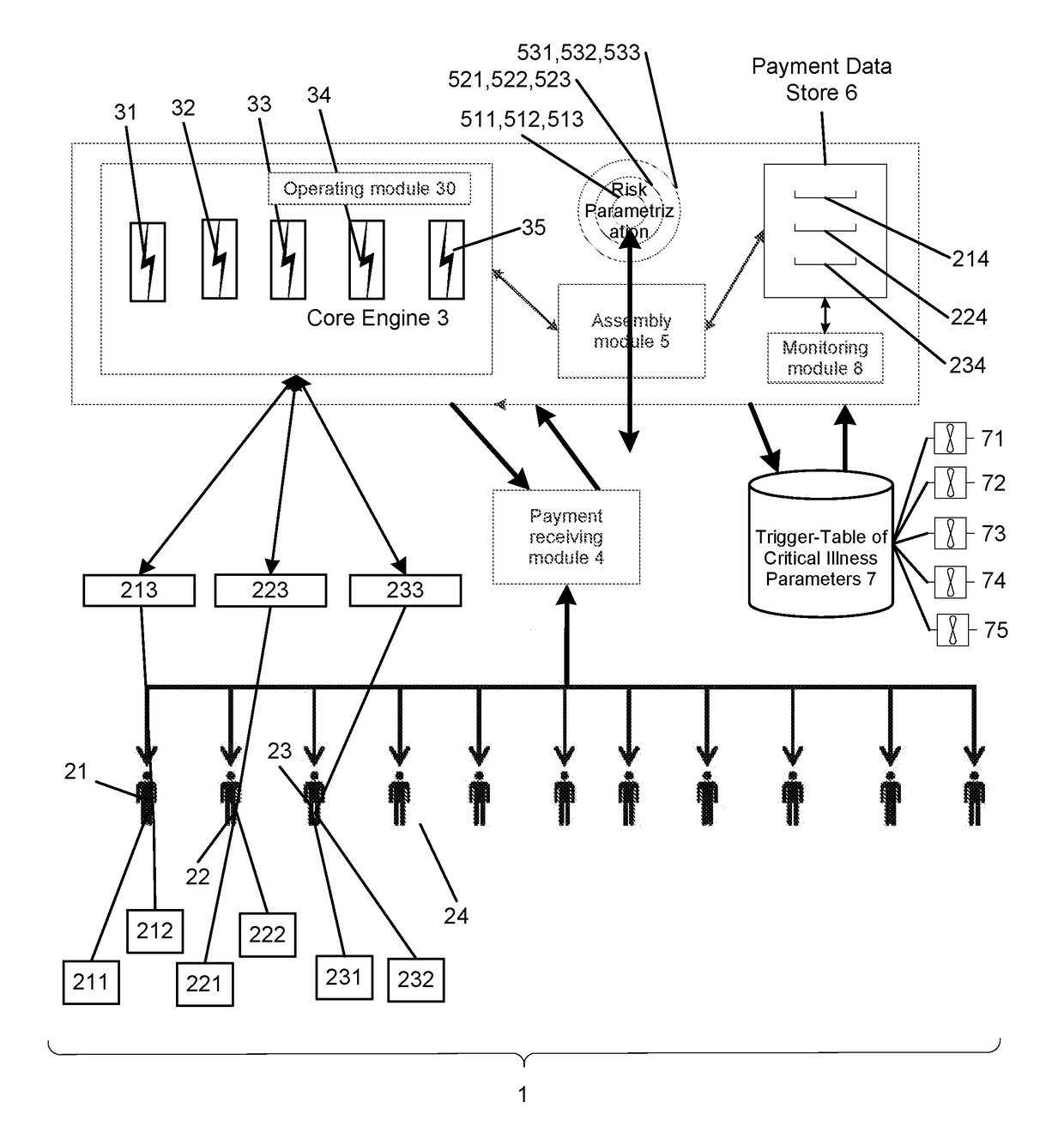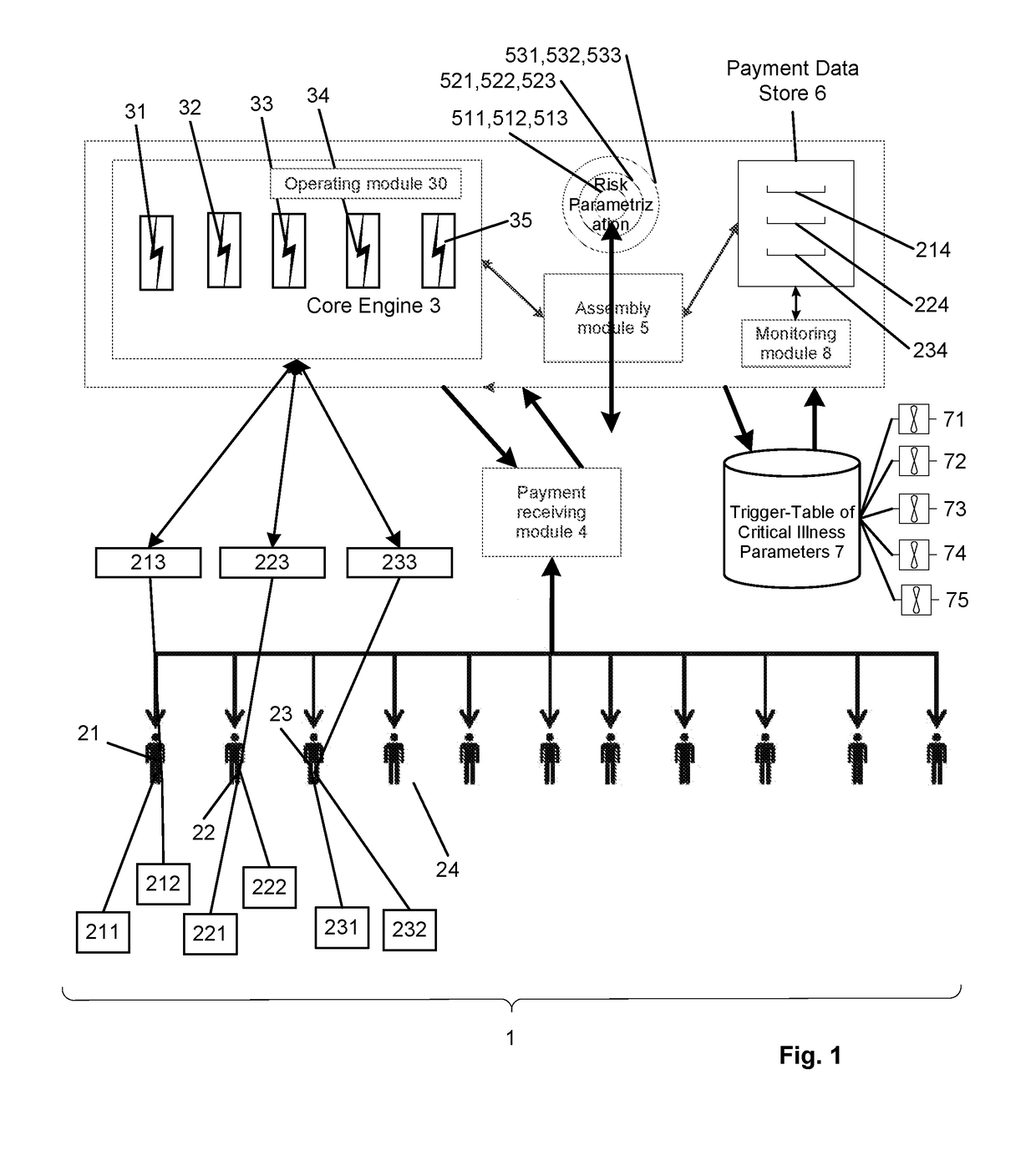In today's lives, there is
significant risk exposure related to many aspects in life and non-life sectors often resulting in an unexpected and dramatic change to the affected individual's life.
This means that predefined quantities of resources are exchanged for the other unit assuming the risk of loss.
One important problem arises due to the fact that life insurance methods are triggered by the death of the unit, the risk of which is transferred.
However, oftentimes problems arise for an individual before then, in that financial resources were threatened by losses occurring prior to death as a consequence of the events leading to the inability to lead an independent life.
Typically, the patient is faced with increasing costs for
medical treatment or other related costs, such as travel expenses or additional heating costs, as well as the decreasing ability to earn the money needed to meet their monthly financial needs.
This may lead to the need to make many sacrifices; e.g., giving up
independent living, not being able to provide sufficient financial support for care and / or selling their house.
For especially
elderly people, all of these financial concerns negatively affect their health.
Recovery, if possible, is delayed and stress additionally aggravates the already poor health of the elderly person.
However, new needs typically arise for the insured and possibly his / her family, as the insured grows older.
For example, medical needs of terminally or chronically ill individuals may require large resources of cash or other liquid assets to pay for services that are not covered by the individual's health insurance or social security programs.
One of the problems is that when a terminally or chronically ill person, age 65 or older, wishes to enter a
nursing home or other assisted living facility and further wishes to use social security programs to fund the person's stay and care, in many countries, state social security regulations generally require the person to divest himself or herself of substantially all liquid and liquidatable assets, subject to state-specific exemptions.
For example, countries generally limit the face value of life insurance of an assisted living, social security recipient to a small amount.
Thus, in many cases, a considerable amount of a person's life insurance is vulnerable to divestment in order to receive social security funding allowing for covering assisted living expenses.
First, if there is a life insurance risk transfer associated with the elderly person, the elderly person can simply cash in his or her policy for whatever cash value is in the policy.
However, the cash value is often very small when compared to the costs of funding assisted living services and does not generally afford the social security applicant sufficient funds to pay for living expenses associated with residing in a
nursing home, an assisted living center, a long-term
care facility, or any other assisted
living environment, as e.g. assisted living centers and especially assisted living services at the individual's
private home.
Moreover, due to the substantial nature of the costs associated with providing assisted living services, the cash value of the elderly person's life insurance policy is typically incapable of providing any significant
delay in connection with the need for social security or other governmental assistance funds.
Although such accelerated death benefit systems have been slowly evolving in recent years, such systems typically can provide such risk transfer only for policies in which the owner is the insured and only when either the
life expectancy of the insured is short, e.g., twelve months or less, or the insured' s illness,
disease, or condition falls within certain specified categories.
Presently, the amount of a viatical settlement is often largely unregulated, although the
cash payment made to the policy owner is required to be more than the cash value or accelerated death benefit, if any, of the policy.
Although in said methods some or all of the face value of a life insurance policy is available to the risk-transferring person, i.e. typically the policy owner, none of the methods require or ensure that the proceeds received by the policy owner are used to pay the living expenses of the policy owner while the policy owner resides at an assisted living facility.
Since the policy owner or his / her designee has no obligation to use the liquidated or divested proceeds to cover assisted living expenses, state assistance programs, such as social security programs, often do not reap any benefit from the elderly person's divestiture of life insurance policies.
In addition, there is currently no procedure for advising an individual elderly person as to his / her various options for divesting of his / her assets and life insurance policies to increase the assets used by that individual to pay assisted living expenses, and thereby temporarily defer his / her reliance on government assistance.
One of the problems of these risk
transfer system as provided by the prior art lies in the fact that the incidence of a condition may vary (i.e., increase or decrease) over time, and the diagnosis and treatment may improve over time, such that the financial need to cover some illnesses deemed critical a decade ago is no longer considered necessary today.
It is very difficult to adapt the prior art systems to such changing conditions without
human interaction, What is clear is the fact that the financial hardship at the time of diagnosis and afterwards increases during the course of treatment, which seldom can be met by the prior art systems, Furthermore, operating the systems of the prior art requires a high level of human resources, because these systems cannot be adequately automated.
Therefore, a large quantity of the pooled resources is used by the resource pooling system itself to administer the risk transfer, which makes the risk transfer expensive for the risk-exposed unit, Finally, another problem of traditional
critical illness risk transfer systems comes from the fact that, due to medical progress, many patients covered by the
critical illness risk
transfer system no longer die, but can survive for many years after undergoing treatment for a heart
attack,
stroke and
cancer.
Due to the long
survival period, such individuals, who were already struck once by a
critical illness, continue to be exposed to the risk of a second or subsequent occurrence of a serious illness, In fact, especially with elderly persons. the risk typically does not decrease, since the health of these patients is already weakened by the first incidence of a serious illness.
Since critical illnesses are traditionally meant to lead to death, the risk involving such individuals, who may be affected by a second or even more critical illnesses, which may lead to an even higher degree of inability to live independently, is no longer covered by the normal one-time
payment of a critical illness risk
transfer system.
However, a combination of critical illnesses is precisely a characteristic feature of serious elderly illnesses leading to different levels of inability to live independently and not to direct death of the elderly person, Therefore, based on the typical one-time parametric
payment transfer of critical illness system, although the patient survived his first bout with a serious illness, the elderly person may, at least financially, not survive the second time in dealing with the badly needed resources to keep up with the expenses for assistance for
independent living, since this is typically associated with cost-intensive long-term care and services.
Often, assistance for independent living is need just due to general
ageing and / or weakening of the ability to look after oneself (frailty).
These cases completely fail to trigger the critical illness risk-transfer systems.
For risk transfer in relation to serious elderly illnesses, another major limiting feature of traditional critical illness insurance systems is related to mandatory boundary conditions for these systems given by age restrictions for critical illness risk transfer.
Traditionally,. critical illness systems are only able to provide risk transfer for individuals by means of predefined schemes, e.g.,. a predefined child scheme restricted to the age of 30 days to 17 years, and for example a predefined adult scheme associated with risk transfer for individuals between 18 and 50 years, Above the upper limit (here 50 years), the system does not allow a new individual to
pool resources in exchange for risk transfer of critical illness, In some systems, the actual risk coverage is longer, e.g., up to the age of 65 years, However, in those cases the individual must also have applied to the system before the first upper limit (here 50 years).
Therefore, the known system for critical illness risk transfer, equal to the typically predefined scheme of traditional life insurance risk transfer systems, are necessarily restricted to age conditions such as boundary requirements.
Older individuals cannot be captured and covered by these systems anymore.
Another
disadvantage of the state of the art systems, which is especially relevant for risk transfer for serious elderly illness risk for older individuals, is already mentioned above.
It is a severe condition, imposing heavy burdens on patients, families, professional caregivers, and the healthcare system,
Distressing symptoms are common,
resource utilization and costs are enormous, return to the
community is rare, and 6-month mortality rates exceed those for most malignancies.
The word reversible used in connection with
dementia means that these conditions are reversible, However, as mentioned, that is not the case with
dementia itself, and the condition / symptoms most likely will deteriorate over time, Despite the fact that there is no known cure, some treatments can potentially also slow down the process, Concerning reversibility, fewer than 10% of cases of
dementia are due to causes that may be reversed with treatment, Some of the most common forms of dementia are: Alzheimer's
disease, vascular dementia,
frontotemporal dementia, semantic dementia and
dementia with Lewy bodies, A patient can exhibit two or more dementing processes at the same time, as none of the known types of dementia protect against the others.
The patient will be faced with increasing costs for
medical treatment or other related costs, and further with the decreasing ability to meet his / her financial needs.
There is a further problem explaining why traditional risk transfer systems related to life insurance risk transfer or critical illness risk transfer fail to provide appropriate mechanisms in relation to dementia as a serious elderly illness, i.e., resource pooling systems for risk transfer associated with the elderly.
However, risk factors for dementia strongly increase after serious elderly illness diagnosis in elderly patients.
Unfortunately, hospitalization increases the risk of a subsequent diagnosis of dementia.
This last risk was time-dependent and only increased the risk 6 months after the patient had been discharged from the hospital.
Therefore, with good reasons,
older people often worry about dementia.
While some risks are well known, for example alcoholism or
stroke, the effects of illness are also significant.
 Login to View More
Login to View More  Login to View More
Login to View More 

